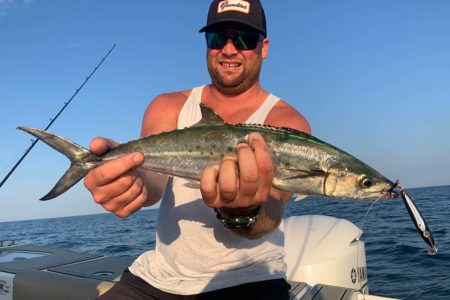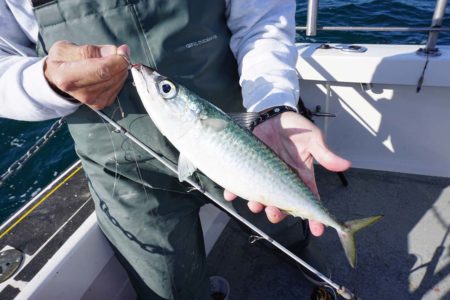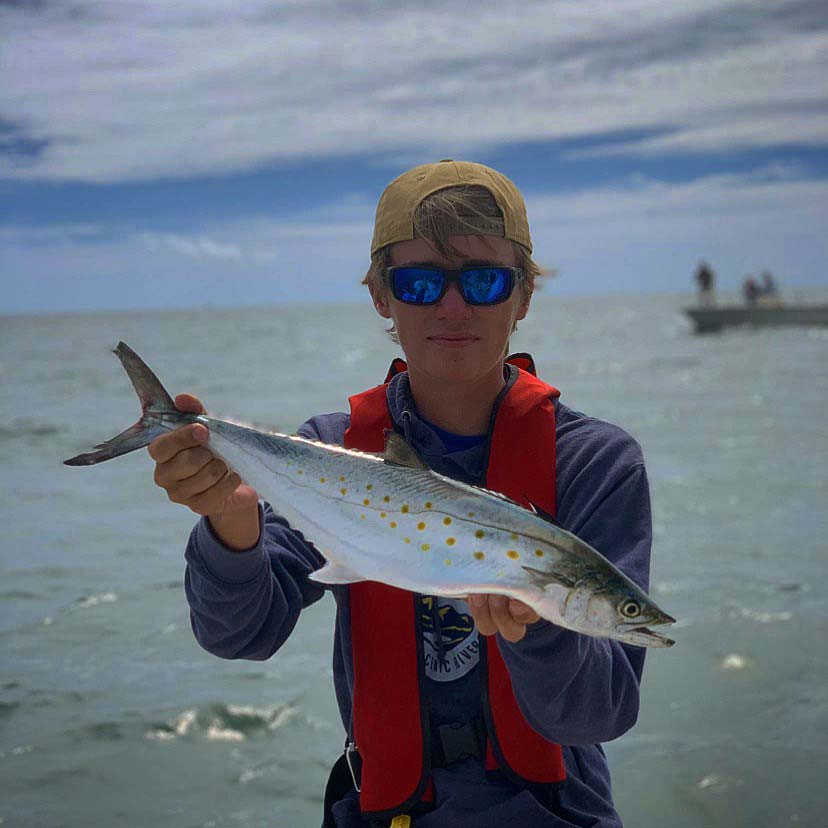
The window for Spanish mackerel is small, but they offer big rewards!
Spanish mackerel are a southern fish native to states like Florida, Georgia and South Carolina, however we are seeing more and more of them in the Northeast as water temperatures warm. Spanish mackerel are closely related to the king mackerel, (which are also being caught in the Northeast, just in lesser numbers). They have a fusiform body shape with big eyes for hunting prey, aerodynamic fins that can tuck in for speed, and rows of sharp teeth.
As water warms in the Northeast, many tropical fish species are showing in places they never have before. The recent arrival of banded rudderfish and jack crevalle has been well documented, and the addition of these exotic mackerel has made for some fun fall fishing with southern species in the Northeast.
And it’s not just kings and Spanish, we’re also seeing frigate macks, and chub mackerel have become more common than bluefish in some cases during the early fall run.
Spanish mackerel follow the Gulf Stream north as the summer progresses, making it into southern New England around late August or early September. They, along with many other species, come north in search of food. Spanish mackerel follow the schools of bay anchovies, peanut bunker and butterfish north to their summer feeding grounds. They don’t typically stay for long, usually only September into early October, but they do provide a fun fight on light tackle and good table fare.
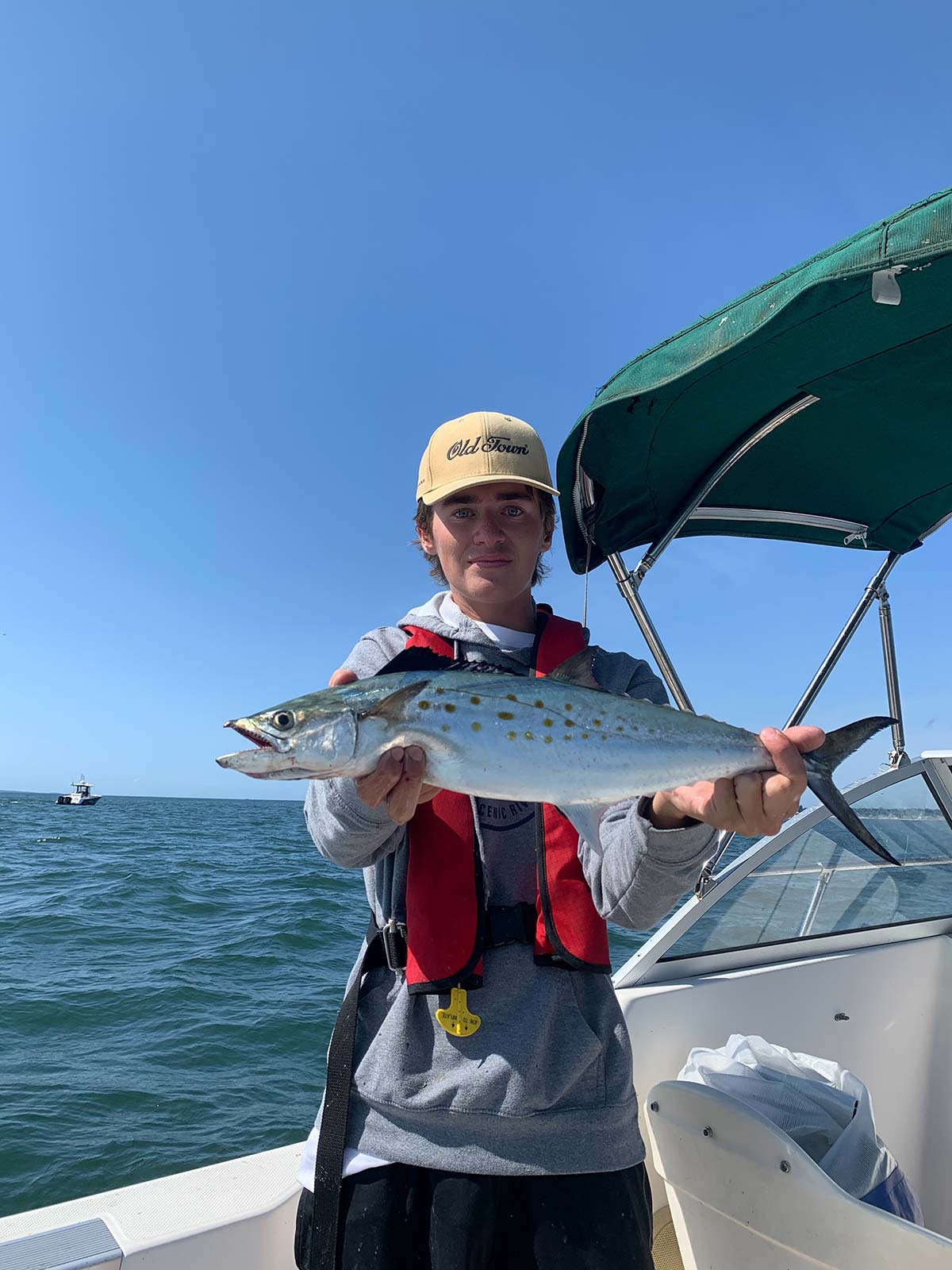
How To Find Them
Being a southern fish, Spanish mackerel like warm water. Some of the best places to start are warm water outflows, such as those exiting power plants, factories and the mouths of shallow rivers. However you may also find them randomly blitzing along beaches and in rips when everything lines up. The key is to find bait. If you can locate schools of small “rain” bait, the Spanish won’t be far behind. I can’t stress enough how important it is to find the warmest water you can. These fish like to be near deeper water where they can escape at a moment’s notice. I’ve seen them mixed in with bluefish at times as well, so don’t be afraid to fish areas where bluefish are blitzing.
Because these fish move really fast it can be hard to nail them down, meaning you may not find them in the same place two days in a row. Basically, if you hear reports that they were in some specific place yesterday, just take it as knowledge that they are around and start eliminating the warm water spots first. Some days you get them and others you don’t, so don’t get discouraged if you can’t find them on your first outing.
The Catch
Since they arrive at the same time as albies, bonito and chub mackerel, they can be hard to differentiate when seen blitzing. All three species can blitz together and may look very similar. Blitzing Spanish mackerel usually show as speeding torpedoes, slashing through schools of bait. Sometimes they will leap clear out of the water like dolphin. They are very exciting to watch, it’s a spectacle that will get any angler’s blood boiling. These fish are FAST. Not as fast as albies, but it is often necessary to run the boat up on plane in order to keep up with the school of fish.
| TABLE FARE? |
| I have only eaten Spanish mackerel once and I have to admit, I didn’t enjoy it. But many anglers rave about them, and since these fragile fish die quickly when removed from the water, keeping a few is not a bad idea. I have heard that smoked Spanish mackerel is a delicacy, as well as sashimi-style sushi. If you plan on keeping a few Spanish, bring a cooler with ice and a knife. Bleed the fish out immediately and get it right on ice. Like bonito, these fish get mushy fast, so ice is mandatory. We don’t get many sashimi-grade pelagics in our inshore waters, so take advantage! |
Once you locate a school of bait, wait for fish to arrive. Or vice versa, if you find a school of fish with little to no bait, search around for some bait and wait for the mayhem to begin. You can catch these fish blind casting into suspected areas of highly concentrated bait, however my experience has been that these fish are almost always caught in blitzes.
Once you find blitzing fish, don’t drive around from school to school, this will not only risk putting the fish down, but will also anger other boaters around you. Wait for the fish to come to you. Position the boat in an area where the schools may surround you. Wait for a school to come within casting range and fire a cast at them. I suggest casting over the blitzing fish and reeling the lure through the school. Like albies and bonito, a fast retrieve typically works best. Reel the lure just fast enough that it stays beneath the water, but not so fast that the lure skips across the surface. Spanish will often follow your lure for a while before striking, if you notice this, give the rod a few twitches that will usually trigger them to attack. These fish make blistering runs and will often jump, the fight is awesome! I recommend using a net to land them, as they have soft mouths and typically will pop off the hook if you attempt to ‘boat-flip’ them.
The way we catch Spanish mackerel in New England is complete opposite of how they are caught in down south. In Florida, anglers catch them on heavy mono and wire leaders with big spoons and jerkbaits. Once they reach northern waters, much like albies, they feed on smaller bait, making them much more finicky. Having the right equipment is key to success. Light leader and braid, small lures and light rods are key to having fun, and landing fish. Since Spanish mackerel are found feeding on small baitfish, they can become really particular on how lures are presented and oftentimes won’t eat artificials. Many anglers become frustrated with Spanish macks because they will often blitz for several minutes while managing to completely ignore every lure in the box—even following all the way to the boat without taking a swipe.
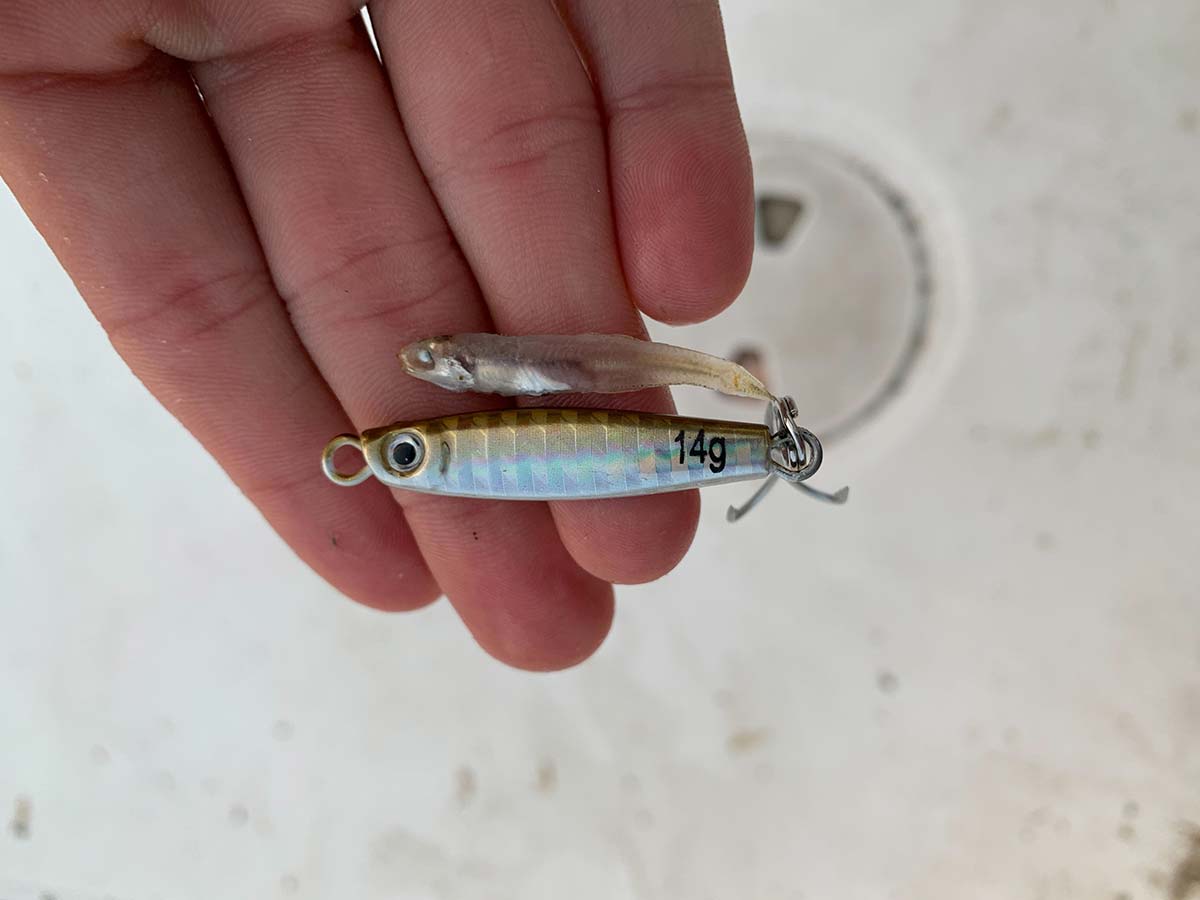
Rod & Reel
When using small lures to match the bait that Spanish mackerel are feeding on, you need a light rod. Something rated medium to medium-heavy. Preferably a lighter spinning rod. You want a rod that’s light enough to cast 1⁄4- to 3⁄4-ounce jigs, yet with enough backbone to handle larger fish. I recommend using a 7-1/2-foot, medium power, fast-action rod like the Tsunami Carbon shield 761M or the G Loomis GLX 902S XF. These rods are light and plenty powerful for Spanish mackerel. They can effectively cast light lures and land larger fish.
You’ll want to pair your light rod with a light reel; something that won’t cause an imbalance in your setup, and with not enough drag to handle blistering runs. Having a long spool helps because the line ‘unloads’ much more easily which delivers longer and more accurate casts. I recommend the Shimano Stradic 3000, Daiwa BG MQ 4000, and the Shimano Nasci 3000. Any reel in the 3000 to 4000 size range will suffice, as long as it features a faster gear ratio and at least 15 pounds of drag.
Line and leader are very important when it comes to maximizing your catch rate because these fish can be so particular. I like to use 10- to 20-pound braid, preferably an eight-strand, which allows for smoother casting. I really like the Daiwa J-Braid 8X Grand 20 pound, specifically in gray, which allows me to see the line, without standing out too much to the fish. No matter your braid color, a leader is a must. I like to use 15-pound Daiwa J-Fluoro. This may seem like a light line for a fish with some serious teeth, which it is. But I have seen evidence that these fish are leader-shy, so I take the risk to get more bites.
The most challenging thing about catching Spanish mackerel is what I call the ‘line-to-teeth ratio’, which basically boils down to fishing the lightest leader line you can get away with, while losing the least amount of jigs. The key to using light leader on hardtails is to tie in an 8-foot leader using a double uni, which gives plenty of leeway for tail wraps and also keeps the braid away from their surprisingly sharp tails, which will part your braid instantly. And because their teeth are large, setting the hook as soon as they hit is a crucial part of landing these fish.
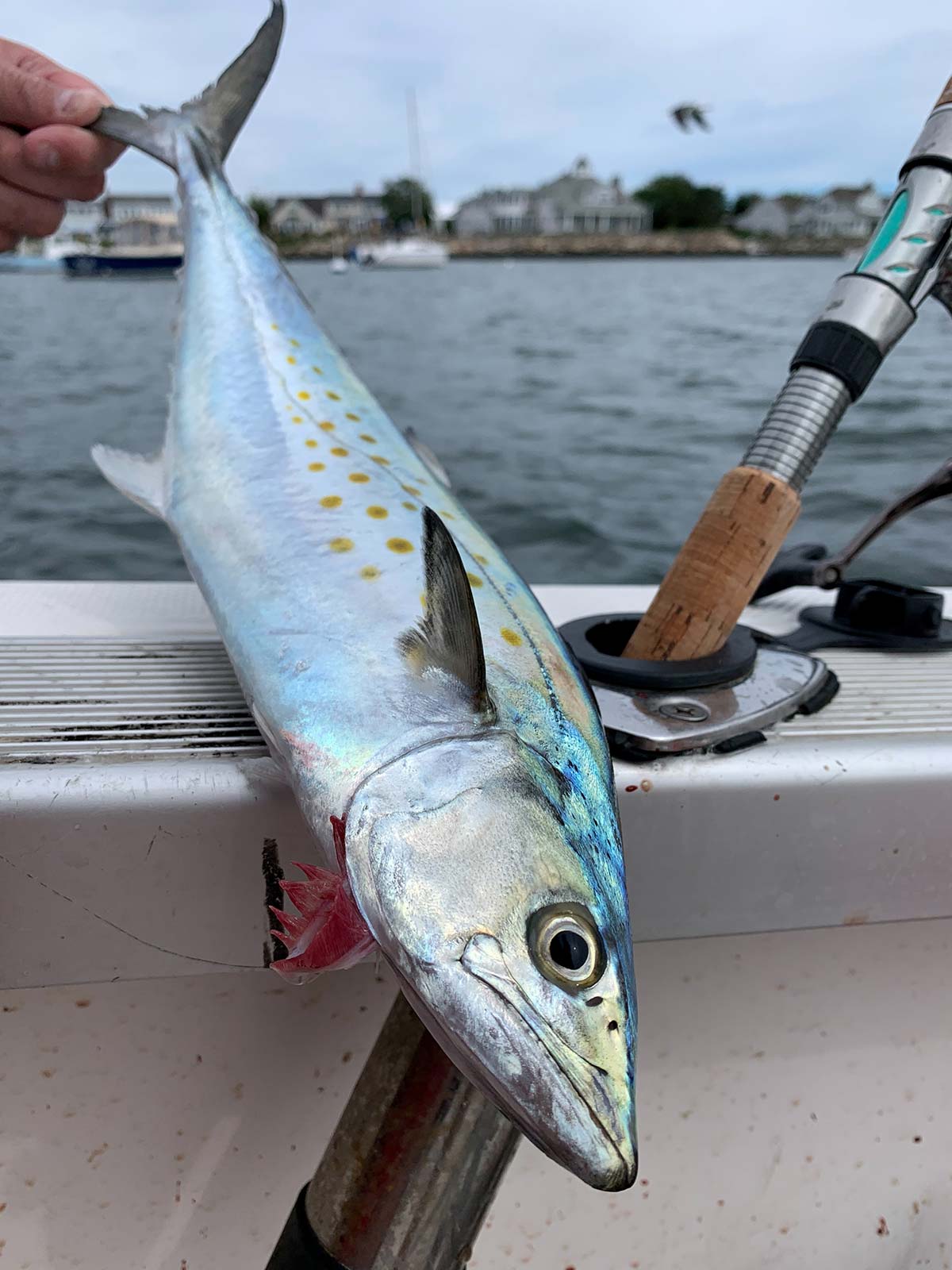
Lures
‘Match the hatch’ is a common term used by all sorts of anglers. However, I find that matching the size of the bait is more important than the color. Spanish mackerel are typically found feeding on what anglers call ‘rain bait’ or ‘snot bait’. It can be very hard to match these baits, as most lures are larger in size. The bait is typically somewhere between 1 and 2 inches long. Some jigs that I have found to work well for Spanish mackerel are the Game On Exo jig in the 3/4-ounce size and the Hogy Heavy Minnow. Both jigs have their advantages and disadvantages, but are clearly the best jigs for Spanish from my experience.
The Game On Exo Jig is a little larger than the Hogy, but weighs the same as the 21-gram Heavy Minnow. The advantage of the Exo Jig is their hard polymer exoskeleton surrounding the metal, which handles their teeth quite well. The advantage of the Hogy Heavy is that it’s smaller, and downsizing is sometimes the only way to get bites. Color doesn’t play a huge role for me, but good colors are green, silver and pink; and I give a substantial edge to silver.
